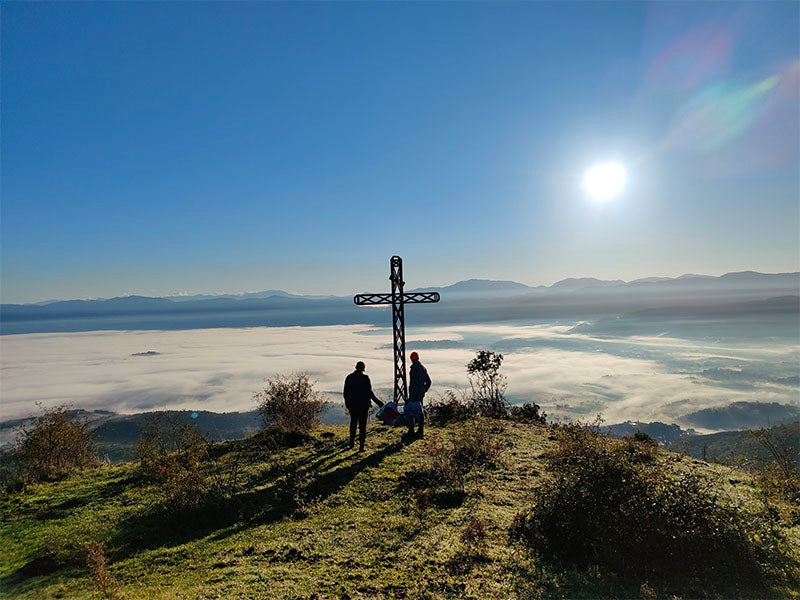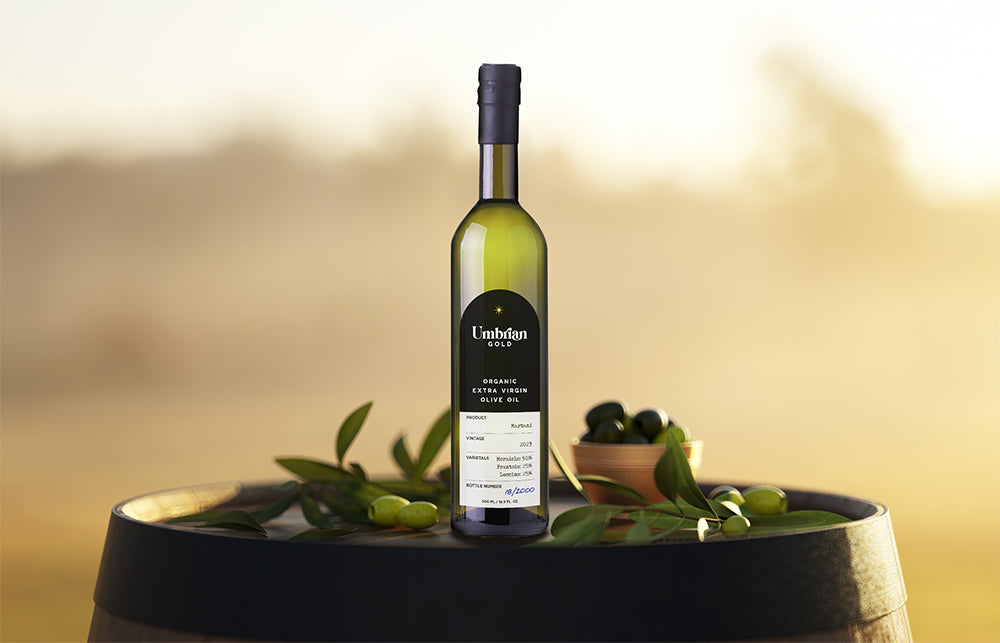
Organic Extra Virgin Olive Oil
Umbrian Gold

Umbria
Umbria is Italy’s most mysterious region. Home of the ancient Etruscans, a civilization that flourished in the shadows of its many hills. With no coastline, surrounded by mountains, Umbria was always hard to reach.
The hills made farming difficult, but Umbrians – shadow people, literally – learned to manage the land despite its uneven terrain, cold winters, and harsh winds. Umbria doesn’t look like the rest of Italy. It’s wilder. Rougher. So are its people, and so are its farms.

Produce grown in these harsh conditions can be extraordinary. Apples, cherries, and apricots are the world’s best, when they survive. Despite the uncertainty, Umbrians grow them, but rarely exclusively. Almost everyone keeps an olive grove, because the varietals planted in Umbria thrive despite the weather. Some years are better than others, but no one can remember a catastrophic season.
Most olive groves are planted on hills. This makes picking the olives difficult, but the slope prevents water from stagnating and ruining the trees.
Olive oil
Umbrians grow olives to make olive oil. This oil is the basis of their cooking.
Rural families consume an average of a liter of oil per week. Oil goes on everything.

Characteristics
Umbrians produce all types and quality of oil. Large producers send enormous quantities throughout Italy and the world. Their product is good by international standards, but the locals like to tell visitors that “they wouldn’t put it in their car.”
The highest quality oil is made by families, from family-owned trees, for their family. Any oil that they can’t consume is sold, usually to the mill. This is the only olive oil we sell.
Umbrian Gold olive oil is “extra virgin”, “cold pressed” and “bio” by default. Most groves are maintained by a single person who’s been doing it for decades. When it’s time to pick the olives, the whole family helps.
Our oil is spicy and full-bodied. People who try it for the first time say that it’s unlike any olive oil they’ve had before. It’s not another level, it’s another category.
Tasting Notes for Martani 2023
Martani 2023 is a blend of Moraiolo, Frantoio, and Leccino. These three olive varieties, the most common in Umbria, give the product a solid structure and balance.
This oil has a fresh, bold nose, with aromas of freshly cut grass, tomato, almond, and artichoke. On the palate, it is smooth and full-bodied, with a gentle back note of spice. The spice intensifies after 7-9 seconds, leaving a lingering warmth on the finish.
Martani 2023 is well-balanced, with complex flavors and aromas, perfect for use in cooking and salad dressing.
Suggested pairings:
- Bruschetta. Drizzle this olive oil over toasted bread, or use it to enhance toppings like fresh tomato, basil, or arugula and parmesan.
- Salad dressing. Whisk Martani 2023 with sherry vinegar, Dijon mustard, shallots, salt and pepper.
- Grilled vegetables. This olive oil is perfect for grilling vegetables, such as asparagus, zucchini, and eggplant. Pour fresh oil over the vegetables before serving. Nothing healthier!
- Pasta. Add a drizzle of this olive oil to your favorite pasta dish for a boost of flavor.
- Dipping oil. Serve this olive oil with bread and salt for a simple and delicious appetizer.
Overall, Martani 2023 is a high-quality organic olive oil with excellent flavor and aroma. It is healthy and perfect for everyday use. Use it to enhance any dish.

Family Oil
When we talk about Umbrian olive oil, we only mean the highest quality family-produced product. Umbrians pick their olives early. When they are beaten off the trees they tend towards green, not black. Modern harvesting techniques don’t work. You can’t shake olives off a tree unless they’re ripe, which is too late for great oil. At the start of the season the oil is green, not yellow. Even the latest oil has a green tinge to it.

Olio Nuovo
Freshly-pressed early season oil is called “olio nuovo”, new oil.
Unlike wine which can improve with age, oil deteriorates with time. Oil lasts a year.
Olio nuovo is spicy and well-structured. Its flavors are easily distinguishable.
After a month it mellows noticeably. Flavors blend and accents are less sharp, but the oil’s structure is still evident. This is its noble period. After a year, the structure has all but disappeared. Some Umbrians will continue using it for cooking but, as a condiment it will immediately be replaced by the next vintage.
You’ll be shocked to see how old oil sold in supermarkets tends to be. Worse, many is produced from olives shipped from multiple countries, which means they are far from fresh when they reach the mill. Our olives are typically pressed within 48 hours of being picked.

Families
We have met most of the families that have contributed olives to this vintage. Some groves are as small as 25 trees, some as big as 350. By any standard, the big groves are small!Groves that are producing top-quality olives today were planted at least two generations ago. Olive trees can live to 500 years, but trees that old are rare in Umbria due to frequent seismic activity.

Only one generation ago olives were picked by hand, with ladders and baskets. Today, we use nets and beaters powered by compressed air or batterie. It is still painstaking work. The season starts in mid-October and runs to mid-November. During that month the weather can change from hot and dry to cold and rainy, almost overnight.

Umbrian Gold Olive Oil Martani 2023

-
MARC MURPHY
"Freshly pressed Umbrian olive oil is unparalleled - it's got that perfect kick of spice and a depth of flavor that truly sets it apart. This is the olive oil you reach for to transform any dish. Once you've tasted it, it becomes the standard for every kitchen, impressing anyone who tries it."
-
Asahi Sato
"Martani offers a unique experience with its delayed, soft spiciness, unlike other olive oils whose sharp spice burns the back of your throat."
-
ISABELLA JONES
"Once someone tastes Umbrian Gold they will never go back to mass-produced olive oil. It's another category altogether. "
FAQs
Who's behind Umbrian Gold?
Paul (@paulumbria) started coming to Umbria every year after high school. He now lives here permanently with his family.
Marc (@chefmarcmurphy) lived in Umbria after finishing cooking school. During his time here he worked with local farmers clearing land, planting, harvesting, and learning traditional butchering and preservation techniques. He also learned to cook all the local dishes, almost all of which require olive oil.
Paul uses an average of 50 liters of olive oil a year. Marc barely manages with 150. He has a lot of guests! In addition, Marc exclusively uses Umbrian olive oil at his private event studio in Tribeca (@mmkitchenstudio). This year it will be Martani 2023.
Over the years visitors have left with tins of oil, and then asked us to send more. Without exception they tell us it's the best olive oil they've ever tasted. Last year we sent friends and family over 300 liters, so we finally decided to make it available to even more people.
Where do you ship?
This year we will only ship to the US.
How much is shipping & handling?
When you checkout you can choose between standard and express shipping. In both cases, we use UPS.
For standard shipping (4-10 day delivery), we charge $10 to ship one bottle, $15 to ship two, and $0 (yes, free!) to ship three or more.
For express shipping (2 day delivery), we charge $25 for the first bottle and $5 for each additional bottle.
Do you charge tax?
Only if you ship to New York State.
What if I don't live in the US and still want to buy your oil?
Give Paul a shout via Instagram or email, and he'll see what he can do.
When will I receive my oil?
As soon as we can get it to you.
The first shipment is in New York and two other shipments should be arriving soon.
Can you make sure I receive it by Christmas?
If we can accommodate your order from the first shipment, you should receive it by Christmas if you order now.